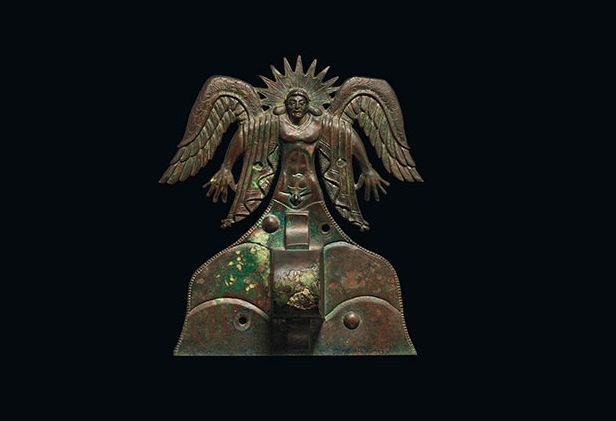The J. Paul Getty Museum announced today the acquisition of an early 5th-century B.C. bronze appliqué depicting the Etruscan Sun God Usil.
 |
| Appliqué depicting the Sun God Usil, Etruscan, 500 - 475 B.C. Italy, Vulci. Bronze. H: 20 cm (7 7/8 in.) [Credit: The J. Paul Getty Museum, Villa Collection, Malibu, California] |
The appliqué represents the solar deity Usil (the equivalent of the Greek god Helios and Roman god Sol), who stands with spread wings and dramatically splayed fingers. A nimbus of rays surrounds the head of the god, who wears a diadem, necklace, and a mantle over his shoulders. At the thighs, the figure merges into a broad plate decorated with undulating lines, suggesting the sea from which the sun emerges at daybreak and sinks at dusk.
Ornamental reliefs such as this functioned as fittings on funeral carts and chariots, which often accompanied the burials of Etruria’s equestrian elite. Probably affixed to the sides of the vehicle, the winged god reflects the imagery of a celestial divinity driving the chariot of the sun across the sky, which was common in Greek and later Etruscan art. The earliest Usil plaque, in the Vatican Museums, was reportedly found at Roma Vecchia between 1760 and 1775 and was illustrated by Francesco Piranesi in 1778. In 1845, four similar plaques were discovered in the Tomb of the Quadriga at Vulci, which preserved the skeletons of horses. Among the appliqués held in the National Etruscan Museum of the Villa Giulia in Rome, the State Hermitage Museum in Saint Petersburg, and other museums, some may belong to that burial. Of that group, the Getty’s Usil appliqué is the best surviving example. Although displaying slight variations in size, facial features, form of the plate, and position of the rivets, all are associated with a preeminent bronze-casting workshop in Vulci.
This newest acquisition will go on display in the reinstalled Getty Villa when it opens in April 2018, and will join several related Etruscan bronzes, including a vessel foot depicting Usil in winged boots running over the crests of waves; and a lion head attachment with glass paste eyes, which likely capped the end of a chariot pole. A pair of candelabra with finials of a youth dancing and playing castanets is also attributed to a Vulcian workshop, which produced fine metalware for an international Mediterranean clientele.
The appliqué was acquired in the 1920s in Monte Carlo by Sylvie Bonneau-Arfa (b. about 1907), née Fatma-Enayet Arfa, the daughter of the Persian ambassador to the Russian court. In 1970 the appliqué went up for auction but failed to sell and was returned to the family. It had been brought to the attention of the Swiss archaeologist Hans Jucker in 1968, and was subsequently on loan to the Historisches Museum in Bern, Switzerland during the 1970s. The Getty acquired it at auction from the descendants of Ms. Bonneau-Arfa.
“This wonderful addition to the collection alongside the related objects in the new Etruscan gallery will introduce visitors to the art of Etruscan bronze sculpture, the significance of celestial divinities in Etruscan religion, elite burial practices, and the impressive parade armor of ancient Italy,” says Jeffrey Spier, senior curator of antiquities at the J. Paul Getty Museum.
Source: The J. Paul Getty Museum [February 07, 2018]
